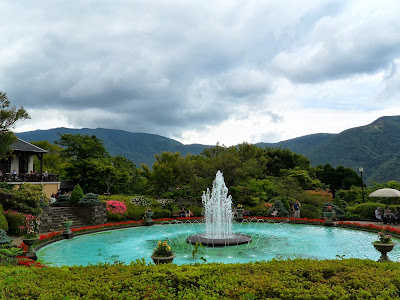 |
| B&B Pension–cheap and clean, ¥3000 per night, breakfast included |


For our last day in our Hakone trip, we had a hard time deciding between the Glass Museum and Gora Park. Our main reason for wanting to go to both was because we had a writing assignment (which I still haven't written, by the way =O) for Japanese class where we needed to compare the two. Reading about it in the travel pamphlet gave me a reason to go.
In the end, we decided to start out at Gora Park and see how it goes from there.



On the way into the park, there were souvenir shops selling these cute glass figures.
Gora Park is a western-styled landscape park. On one side, there is a French-styled Rose Garden with a large fountain, and on the other there is a tropical botanical garden. Luckily for us, we came at the right time of year to see the Ajisai (hydrangea) Exhibition.



The tropical garden had a lot of exotic plants and flowers. There were coconuts (left) and papaya (middle). And by chance, I saw this strange-looking creature (right). Anyone have any idea what it is?
 \
\
It was also my first time seeing pineapple being grown. It smelled sooo good.


The ajisai exhibition had so many ajisai. I never knew they came in so many colors!




Coffee and rose flavored ice cream, while watching the beautiful mountains around us.
The Rose Garden was just above the fountain. It wasn't blooming with roses, as I had imagined–in fact, it was quite sporadic–but looking at each flower individually, you start to see that less is more.




Each type of rose had its own name: Princess Michiko (top right), Princess Hisako (bottom left).
Aside from the gardens and flowers, there is a crafthouse, where people can make glass and pottery, and learn dry flower arrangement. Each activity costs between ¥1000 - ¥3500.
Because we didn't have time to spare, though, we didn't stay to do anything.




We did look around the shop, though.


incense holders
It took us hours to finish going around the park. By the time we were done, it was already well into the afternoon. We wanted to go to the Glass Museum, but we wanted to see owakudani even more. To get there, you need to take the cable car again, whose service stops at 5pm. So with a but of regret, we headed towards the cable car.
At Gora Station, there was a small shop selling Gora manjuu (steamed buns). Thinking it was something special, I bought two to try.
So was it anything special? Not really. That, or maybe I just don't really like manjuu.
Owakudani (大湧谷) literally means "great boiling valley". It's a crater that was created during the last eruption of Mount Hakone 3000 years ago. It's still an active volcano today, with active sulfur vents and hot springs, but because of the scenic views, it has become a popular tourist attraction. From the ropeway station, there is a ten-minute walking trail where you can enter the volcanic zone to see the steam vents and bubbling pools.


View from the ropeway: you can see the sulfur (the yellow stuff).


The walkway was really crowded.


On the walkway, you can see streams of this milky colored water flowing downhill. As you climb higher, the temperature of the water gets hotter.


And you also begin to see a lot of steam vents, which smell really bad due to the sulphuric fumes.


Boiling water. Eggs are actually cooked in these hot springs.
 |
| At 1050 meters above sea level. |
The yellow rocks that you see on the mountain are actually the areas that the lava burned 3000 years ago. Even now, the crater still discharges fumarolic gas containing poisonous hydrogen sulfide and sulfur dioxide, which is why trees are unable to grow there.
At the souvenir shops, a lot of black-themed delicacies are sold, including the famous hard-boiled eggs (that you saw cooking in the water above).
They're sold in batches of five for ¥500.


The reason they're black is that the water they're cooked in contains sulfur. Inside, they're not any different from regular hard-boiled eggs. However, people say that consuming the eggs can increase longevity: one egg adds seven years to your life, but be careful not to overdo it; you may eat up to two and a half for a total of seventeen and a half years, but eating a third whole is highly unadvised.


Other things that are sold here are kuro monja manjuu (kuro, meaning black, monja as in monjayaki, which is the filling, and manjuu, the bun),
fried potato (which was soooo good omg), and custard-flavored ice cream (they also had black ice cream).
We left Owakudani on the last car down the ropeway. From there, we headed back home to Tokyo.
The cable car ride back to Gora Station.
I recorded the ride on the Hakone Tozan Railway because thousands of ajisai were blooming along the tracks.
So my second visit to Hakone proved to be really worthwhile. I really do believe that people change as they get older. Three years ago, I hated Hakone because I was a big city girl, interested only in shopping and high-tech luxuries. This time, all I want to do is escape from the stressful city life and indulge in nature.














No comments:
Post a Comment